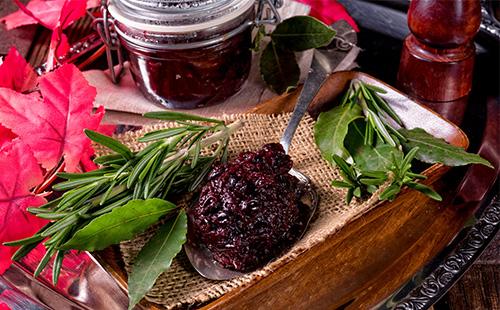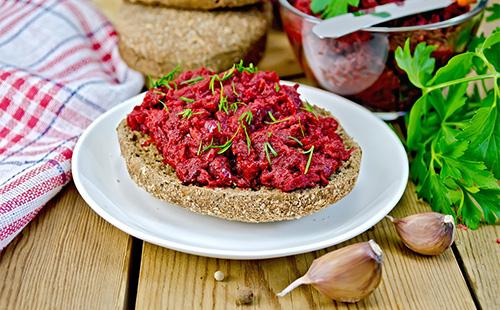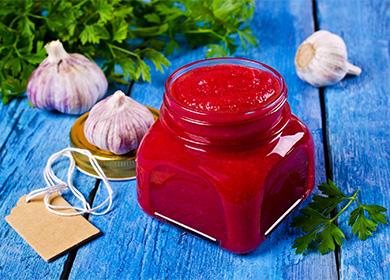Beetroot is a low-cost, unpretentious vegetable in growing. The product seems commonplace, but it has a rich history. To make it more interesting for you to cook beetroot caviar, remember some interesting facts about root crops and share them with your loved ones at a meal.
- Looks like a carrot. Wild beets, which was first tried by man, had an elongated thin shape. The root crop became round, as we know it now, only in the 16th century, thanks to the efforts of breeders.
- Halloween symbol. Pumpkin became a generally accepted symbol of All Saints Day only in the 19th century. Prior to this, the British and Irish preferred beets, turnips and swede.
- The most delicious is the tops. That is what the inhabitants of the Mediterranean, who lived before our era, believed. They only ate leaves, and the root crop was considered a valuable medicine.
- Tribute to the emperor. When the ancient Romans conquered the Germans, Tiberius ordered the vanquished people to supply the burgundy root crop as a tribute.
- Salvation from the plague. There is a theory that the inhabitants of the Balkans were less affected by the plague than the rest of Europeans, since they ate a lot of beets.
- Vegetable Sacrifice. In ancient Greece, the root crop was sacrificed to Apollo. Both real beets and their copies made of pure silver were brought to the temples.
- Love potion. In ancient times, it was believed that if a woman and a man eat a piece of the same beet, they will love each other and will live soul to soul.
- The symbol of contention. Ancient Persians negatively related to beets, considering it a symbol of gossip and quarrels, because the color of the vegetable resembles blood. The fetus was used only for medical purposes in case of emergency.
Root benefit
Despite the excellent taste of beets, not everyone liked it. And very in vain. Nutritionists claim that this is the only herbal product that can not be replaced with anything in the diet - it is so useful. There are at least six reasons why you need to eat burgundy root crops.
- Prevents heart disease. Beets are rich in glycine betaine. This phytochemical compound neutralizes homocysteine, the main cause of vascular plaque formation. Thus, regular use of root crops reduces the risk of heart attack and thrombosis.
- Prevents fetal neural tube defects. 100 g of beets contains almost 30% of the daily intake of folate. This substance is indispensable for the female reproductive system. In particular, it is necessary for expectant mothers.
- Cleanses the body of all unnecessary. Fiber frees the intestines from toxins and destroys putrefactive bacteria, and vitamin C neutralizes toxins and free radicals.
- Normalizes the thyroid gland. And all thanks to the presence of iodine in the chemical composition. And also this element prevents the development of atherosclerosis.
- Prevents early aging. There are a lot of amino acids in the root crop, which allow the body to stay young inside and out longer.
- Relieves nervous tension. A serving of beets per day will make you less vulnerable to stress and anxiety. The mood will be elevated, and performance will increase.
5 criteria for choosing quality raw materials
It’s good to have your own garden. You can be 100% confident in the quality and safety of vegetables grown. It is only important to choose a good beet variety. Summer residents appreciate the taste, germination and keeping quality of Bravo, Bordeaux 237 and Two-seeded TSHA. And those who have not yet been lucky enough to become the owner of their own beds, should arm themselves with five criteria for choosing high-quality beets.
- Weight and size. A high-quality fruit should be no more than 12 cm in diameter and no heavier than 400 g. Everything else is either fodder beets or a product grown on chemical fertilizers.
- Peel. Carefully inspect the skin. It should be thin, but strong. Unacceptable mechanical damage, stains and traces of rot.
- Colour. The root crop should be dark red with a purple tint. The more saturated the color of the vegetable, the more valuable betaine is in it.
- Incision. The color of the pulp should be uniform. A white core, rings or chaotic light inclusions is a sign of an increased content of nitrates.
- Tops. If you are lucky enough to find a root crop with leaves, do not pass by such a product. By the state of greenery, you can determine the freshness of the vegetable itself. In addition, beet tops are incredibly useful.
Beetroot caviar for the winter: a traditional way ...
Beetroot caviar is a tasty and healthy dish. The blank is good as a side dish, as an independent dish, as a spread for sandwiches or as a basis for soups and salads. Thanks to the recipes described step by step, cooking is not difficult.
Classic
Features The basic recipe for beetroot caviar is simple and excellent in taste. You can eat the billet on your own, serve as a side dish or use in salads (for example, in a Fur Coat). From the specified number of ingredients, 2 liters of caviar are obtained.
You will need:
- 2 kg of beets;
- 1 kg of onion;
- half a glass of sunflower oil;
- a third of a glass of vinegar;
- 20 g of salt.
Step by step
- Boil the beets.
- When it cools, clean and rub.
- Chop the onion.
- Combine all components and boil.
- Simmer 20 more minutes.
- Transfer the hot workpiece to a sterile container and seal.
... and 9 variations on a burgundy snack theme
With garlic
Features Fans of spicy food should definitely cook beetroot caviar with garlic. A rich snack will delight taste buds and protect against colds. And to mitigate the severity, before serving, the dish can be seasoned with mayonnaise or sour cream. From the specified amount of ingredients, the amount of snacks equivalent to
2 l
You will need:
- 2.5 kg of beets;
- two heads of garlic;
- a third of a glass of sunflower oil;
- 30 g of sugar;
- the same amount of salt;
- a quarter cup of vinegar essence.
Step by step
- Boil the beets and grate.
- Heat oil, add beetroot mass and simmer for 20 minutes.
- Add the squeezed garlic and simmer another five minutes.
- Add the essence, put it in jars and cork.
Fried
Features Fried beetroot caviar is especially aromatic and piquant. Therefore, housewives use it not only as a side dish, but also as borsch dressing. About 2.5 liters of the workpiece will be obtained from the indicated amount of ingredients.
You will need:
- 1.5 kg of beets;
- 500 g of carrots;
- as many onions;
- two heads of garlic;
- 200 g hot pepper;
- a glass of sunflower oil;
- 20 g of salt (you can use aromatic salt with dried herbs);
- a glass of tomato paste;
- 10 ml of vinegar essence.
Step by step
- Raw beets and carrots grate.
- Chop onion, garlic and pepper.
- Fry onion and pepper in hot oil. After five minutes, add the carrots, after another five minutes - beets.
- After a quarter of an hour, the turn of garlic, salt and tomato comes. Cook another ten minutes.
- Distribute the workpiece in sterile jars, add essence and roll up.
With semolina
Features Beetroot caviar, twisted through a meat grinder for the winter, is especially tender. Thanks to semolina, the workpiece acquires a pleasant viscous consistency, it is convenient to spread on bread. About 2.5 liters of caviar are obtained from the indicated quantity of products.
You will need:
- 500 g of beets;
- as many onions;
- 1 kg of carrots;
- 1.5 kg of tomatoes;
- 100 g semolina;
- a glass of sunflower oil;
- 40 g of sugar;
- the same amount of salt;
- 5 g ground pepper;
- 10 ml of vinegar essence.
Step by step
- Feed raw vegetables through a meat grinder.
- Add oil, pepper, sugar and salt. For two hours, simmer the mass on a weak burner power.
- Gradually enter the decoy. Stir constantly to prevent the groats from clumping.
- After 20 minutes, add the essence, distribute in sterile jars and cork.
With green tomatoes
Features If at the end of the harvest season, unripe tomatoes remain on the bed, add them to beetroot caviar. The workpiece is obtained - you will lick your fingers! Actually, in many sources it is called that. About one and a half liters of caviar comes out of these products.
You will need:
- 1 kg of beets;
- 500 g of green tomatoes;
- as much bell pepper;
- as many onions;
- ten peas of black pepper;
- a glass of vegetable oil;
- 50 g of sugar;
- 25 g of salt.
Step by step
- Peel and grate the beets.
- Finely chop the tomatoes, onions and peppers.
- Heat oil in a deep frying pan and send onions to it.
- When it becomes transparent, add all other ingredients. Stew for 45 minutes.
- Distribute into jars, sterilize and roll up.

In a slow cooker
Features Beetroot caviar in a slow cooker is simply and quickly prepared. A powerful modern device provides high-quality heat treatment, so the workpiece is tender in texture and rich in taste.
You will need:
- 1.5 kg of beets;
- two onions;
- half a glass of tomato paste;
- two tablespoons of vinegar;
- salt and sugar at your discretion.
Step by step
- Peel and grate boiled beets.
- Turn on the slow cooker in the “Baking” mode, add a little oil to the bowl and send the finely chopped onions.
- When the onion fries until golden, add the tomato and cook for another five minutes.
- Add beets and other ingredients to the bowl. Cook for 15 minutes in the same mode.
- Put the device into the "Extinguishing" mode, close the lid and cook one and a half hours.
- Dispense in a sterile glass container and roll up.
With horseradish
Features Delicate sweet beets and spicy horseradish - this is a classic combination. The appetizer is especially tasty in tandem with a rich jelly. And a simple recipe for spicy caviar with beets will come in handy during colds.
You will need:
- 1 kg of beets;
- 200 g of horseradish;
- two tablespoons of vinegar;
- salt and sugar at your discretion.
Step by step
- Scroll the boiled beets in a meat grinder.
- Do the same with peeled horseradish.
- Combine all the ingredients, put them in jars, sterilize and roll up.
With apples
Features Canned beets with apples are not only flavoring, but also a real vitamin explosion. Multicomponent caviar will delight you with a rich aroma in severe frosts, when you really want to eat something natural and healthy. The specified amount of ingredients is enough to cook about 4 liters of the workpiece.
You will need:
- 1 kg of beets;
- as many tomatoes;
- as many apples (sour varieties);
- as many onions;
- as much bell pepper;
- as many carrots;
- hot pepper pod;
- head of garlic;
- lemon;
- 75 g of sugar;
- 10 g of salt;
- a glass of vegetable oil.
Step by step
- In a large container, heat the oil and add the onion chopped in half rings.
- When it turns golden, add the tomatoes and hot peppers scrolled through the meat grinder.
- After five to ten minutes, add grated peeled apples, carrots and beets.
- After another 10 minutes, send the diced pepper into the bowl.
- Stew the preparation for an hour, then add the squeezed garlic and lemon juice.
- After five minutes, lay the blank in sterile jars and roll up.
With zucchini
Features Zucchini is a versatile vegetable. He is "friends" with all the neighbors in the garden, adapting to their taste and color. Zucchini perfectly "get along" with beets. They allow you to increase the volume of the workpiece and make its taste more delicate.
You will need:
- 1 kg of beets;
- 2 kg of squash;
- 1 kg of onion;
- a quarter cup of vinegar;
- a glass of sugar;
- 30 g of salt;
- half a glass of sunflower oil;
- a pinch of cinnamon;
- two inflorescences of cloves.
Step by step
- Grate the beets and zucchini, and chop the onions finely.
- Combine all ingredients and boil.
- Stew for another 40 minutes over low heat.
- Arrange on banks, sterilize and roll up.

With eggplant and mushrooms
Features The sharpness of the eggplant and the sweetness of beets is a great combination for vegetable caviar. And mushrooms will complement this taste picture and make a festive salad from a traditional snack.
You will need:
- 1 kg of beets;
- 500 g of champignons;
- large eggplant;
- half a glass of tomato juice;
- a third of a glass of oil;
- bulb;
- two cloves of garlic;
- half a glass of vinegar;
- 10 g of salt.
Step by step
- Dice the little blue and soak for 20 minutes in salted water to neutralize the bitterness.
- Boil the beets and grate.
- Grind onions and mushrooms. Fry in hot oil.
- When the onions become clear, add the beets, eggplant, tomato and squeezed garlic. Tomite 40 minutes.
- Add vinegar, place in a sterile container and seal.
If you are only embarking on a healthy diet, beetroot caviar recipes for the winter should definitely be in your cooking piggy bank. But be careful. If earlier beets were not a frequent guest at your table or you did not eat it for more than a month, do not lean on a tasty harvest immediately. After opening the jar, eat only a couple of spoons of caviar, so that the body gets used to it. And you can move on to full servings the very next day.
Other salad recipes
Nezhinsky salad of cucumbers
Cucumber Salad
Cucumber Salads for the Winter
Pickles for winter

